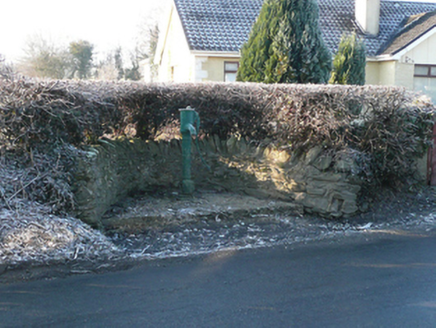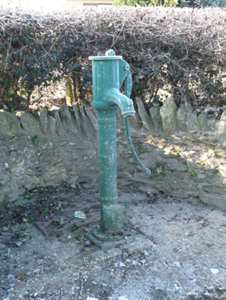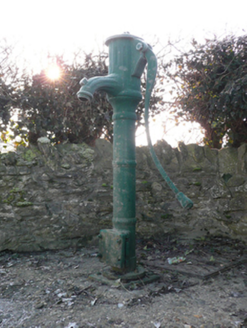Survey Data
Reg No
40834009
Rating
Regional
Categories of Special Interest
Social, Technical
Original Use
Water pump
Date
1870 - 1900
Coordinates
230513, 399657
Date Recorded
19/01/2011
Date Updated
--/--/--
Description
Freestanding cast-iron water pump, erected c. 1885, comprising banded shaft, fluted neck, spout, and with a slender ‘cow tail’ curved handle to the north side. Original domed decorative cap with finial over now removed. Secured to ground by cast-iron plate. Set in semi-circular enclosure enclosed to rear (west) by rubble stone boundary wall having rubble stone soldier coping over. Set slightly back from road to the south end of Ballindrait.
Appraisal
An attractive piece of mass-produced cast-iron, which is an appealing and subtle feature in the landscape to the south end of the small village of Ballindrait. Although the cap is now missing, it survives in relatively good condition. The decorative detailing including banded shaft, fluted neck and the elegantly curved handle, add aesthetic interest to this utilitarian object. This water pump is of particular importance as a reminder of the mechanisms installed for the supply of clean drinking water in the period before mains water supply systems. It would have provided a communal focal point for the local community. Although water pumps of this design are very common features in the rural Irish countryside, particularly in the midlands and the east of the country, it is rare to find pumps of this type in rural County Donegal (later water hydrants are much more common in the county). It is depicted on the Ordnance Survey twenty-five inch map of c. 1903-5 and has been a feature in the landscape of Ballindrait for over a century. There is a feature (unknown) marked at this location on the Ordnance Survey first edition six-inch map of c. 1837, possibly an earlier pump or well. The simple but attractive rubble stone boundary wall to the rear adds significantly to the setting and context. This simple item of street furniture makes a positive contribution to the streetscape of Ballindrait, and is an integral element of the built heritage and social history of the local area.





